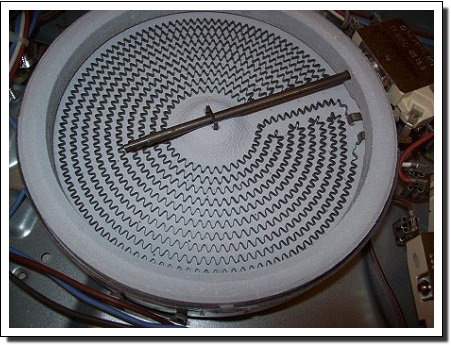Heat from electricity
When heat is caused by an electric current, as in a clothes iron, a toaster or a lightbulb, energy is always transformed from its electrical into its thermal form.
In many cases, we want to keep this transformation to a miniumum because heat energy emitted to the air cannot be used. This is the reason why energy saving lamps are often used instead of usual lightbulbs nowadays. Usual lightbulbs transform about 5% of the electrical energy into light energy while 95% of it turns into useless heat energy.

Image: Inside a ceramic glass cooktop. You can clearly see
the long heating wire.
Of course, with appliances like flatirons or electric stoves, this is different. In these cases, the heat is not worthless but useful. These appliances are equipped with a heating element which transforms electrical energy into heat energy as much as possible. In heating elements the same concept as in usual electric conductors such as wires applies.
Whenever a current flows through the conductor, the conductor heats up. At the same current strength, different conductors (eg. iron or copper wires) heat up differently. Conductors that heat up more are at the same time worse at actually conducting electricity. This is called a higher electric resistance.
Electric resistance can be thought of as a sort of restraint that the conductor applies on the current. The bigger the restraint, the worse the conduction - and the more heat caused in the process.
